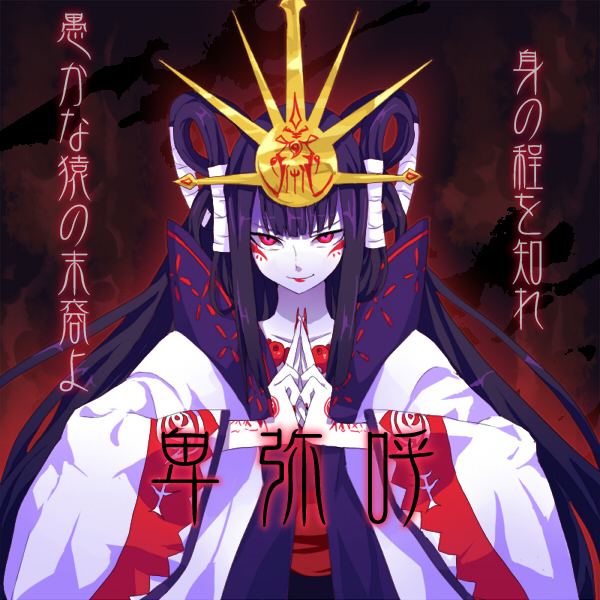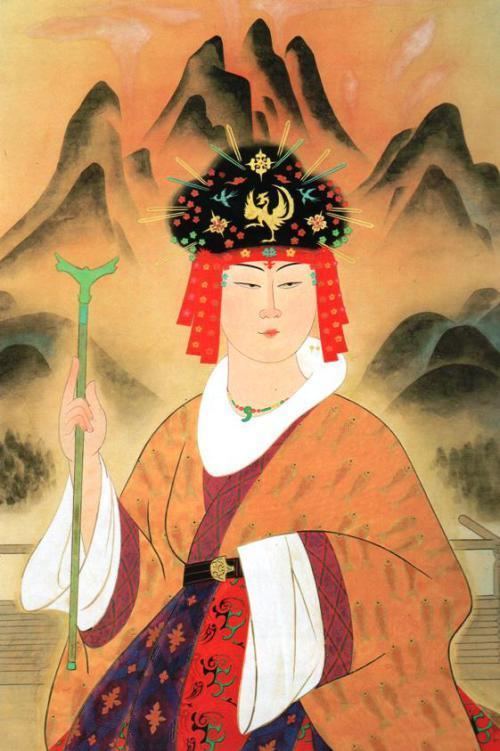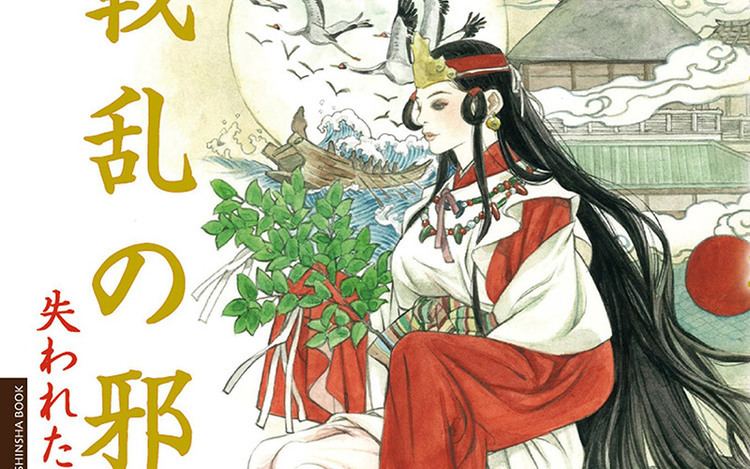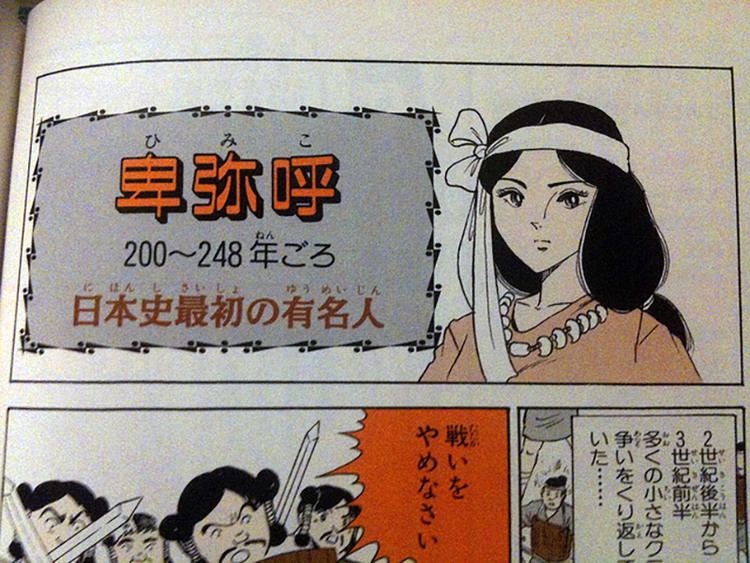Name Himiko Himiko Successor Iyo | Died 248 AD, Japan | |
 | ||
Reign 189 AD – 248 AD (59 years) Similar People Prince Shotoku, Emperor Jimmu, Yamato Takeru, Oda Nobunaga, Sakamoto Ryoma | ||
Himiko den ending song
Himiko or Pimiko (卑弥呼, c. 170–248 AD) was a shaman queen of Yamataikoku in Wa (ancient Japan). Early Chinese dynastic histories chronicle tributary relations between Queen Himiko and the Cao Wei Kingdom (220–265), and record that the Yayoi period people chose her as ruler following decades of warfare among the kings of Wa. Early Japanese histories do not mention Himiko, but historians associate her with legendary figures such as Empress Consort Jingū, who was regent (c. 200–269) in roughly the same era as Himiko. Scholarly debates over the identity of Himiko and the location of her domain Yamatai have raged since the late Edo period, with opinions divided between northern Kyūshū or traditional Yamato Province in present-day Kinki. "The Yamatai controversy", writes Keiji Imamura (1996:188), is "the greatest debate over the ancient history of Japan".
Contents
- Himiko den ending song
- Quest for the lost queen himiko by remote viewing full version
- Interpretations of Himiko
- Name
- Identity and historicity
- Namesake
- References

Quest for the lost queen himiko by remote viewing full version
Interpretations of Himiko

Researchers have struggled to reconcile Himiko/Pimiko between the Chinese and Japanese historical sources above. While the Wei Zhi described her as an important ruler in 3rd-century Japan, early Japanese historians purposely avoided naming Himiko, even when the Nihon Shoki quoted the Wei Zhi about envoys from Wa.
Name

The three Chinese characters 卑彌呼 or 卑弥呼 transcribing the Wa regent's name are read himiko or hibiko in Modern Japanese and bēimíhū or bìmíhū in Modern Standard Chinese. However, these contemporary readings differ considerably from how "Himiko" was pronounced in the 3rd century, both by speakers of the unknown Wa-language and by Chinese scribes who transcribed it. While transliteration into Chinese characters of foreign words is complex, choosing these three particular was puzzling, with literal meanings 卑 "low; inferior; humble", (traditional) 彌 or (simplified) 弥 "fill, cover; full; whole, complete", and 呼 "breathe out; exhale; cry out; call".

In terms of historical Chinese phonology, modern beimihu (卑彌呼) is simpler than its presumed 3rd-century late Old Chinese or early Middle Chinese pronunciation. Compare the following reconstructions of the name 卑彌呼 in "Archaic" or "Middle Chinese" (Bernhard Karlgren, Li Fanggui, and William H. Baxter), "Early Middle Chinese" (Edwin G. Pulleyblank), and, historically closest, "Late Han Chinese" (Axel Schuessler).
To simplify without using special symbols, the first two syllables with p(j)- and m(j)- initial consonants share -i(e) final vowels, and the third has a either a voiceless fricative X- or a voiced fricative h- plus a back mid vowel -u(o). Thus, "Himiko" could be hypothetically reconstructed as *P(j)i(e)m(j)i(e)hu(o).
In terms of historical Japanese phonology, himiko would regularly correspond to Old Japanese *Fimeko. However, Roy Andrew Miller says *Fimeko is a lexicographic error deriving from the Wei Zhi transcriptions.
Most perplexing of the entire list is the name of the queen of the Yeh-ma-t'ai community, Pi-mi-hu, Middle Chinese pjiḙ-mjiḙ-χuo. This has traditionally been explained and understood in Japan as a transcription of a supposed Old Japanese form *Fimeko, said to be an early term meaning "high born woman; princess," and to derive from Old Japanese Fime [or Fi1me1] (also sometimes Fimë [Fi1me2]), a laudatory title for women going with Fiko [Fi1ko1] for men. Later Fime comes to mean "princess," but this meaning is anachronistic for the earlier texts. … The difficulty concerns the supposed Old Japanese word *Fimeko. Even though such a form has found its way into a few modern Japanese dictionaries (for example even Kindaiichi's otherwise generally reliable Jikai), it is in fact simply one of the ghost words of Japanese lexicography; when it does appear in modern lexical sources, it is a "made-up" form listed there solely on the basis of the Wei chih account of early Japan. There never was an Old Japanese *Fimeko; furthermore, the Middle Chinese spirant χ of the transcription suggests that the final element of the unknown original term did not correspond to Old Japanese -ko [-ko1], which is rendered elsewhere – in Fiko [Fi1ko1], for example – with Middle Chinese -k- as one would expect. The final element of this transcription, then, remains obscure, thought there is certainly a good chance that the first portion does correspond to a form related to Old Japanese Fime. Beyond that, it is at present impossible to go. (1967:22)
Hime < Old Japanese Fi1me1 (姫 "young noblewoman; princess"), explains Miller, etymologically derives from hi < Fi2 (日 "sun") and me < me1 (女 "woman").
Tsunoda (1951:5) notes "Pimiko is from an archaic Japanese title, Himeko, meaning 'princess'," that is, hime with the female name suffix -ko (子 "child", viz. the uncommon given name Himeko). Other Amaterasu-related etymological proposals for the Japanese name Himiko involve hi (日 "sun") and miko (覡 or 巫女 "shamanka, shamaness; shrine maiden; priestess"); or their combination hime-miko "princess-priestess".
Identity and historicity
Identifying Himiko/Pimiko of Wa is straightforward within the history of China, but problematic within the history of Japan. The 3rd-century Chinese Wei Zhi ("Records of Wei") provides details about shaman Queen Himiko and her communications with Emperors Cao Rui and Cao Fang. The 8th-century Japanese Kojiki ("Records of Ancient Matters") and Nihon Shoki ("Chronicles of Japan", which quotes the Wei Zhi) disregard Himiko, unless she was the subtext behind their accounts of Empress Jingū, Yamatohime-no-mikoto, or Yamato-totohi-momosohime-no-mikoto.
None of these three legendary Japanese royal shamans adequately corresponds with the Chinese chronology and description of Himiko. Assuming the Wei Zhi account that Himiko died around 248, if one accepts the dubious Japanese traditional dating, then she was closer to the 3rd-century AD Empress Jingū than to the 1st-century BC Yamatohime-no-mikoto and Yamato-totohi-momoso-hime. On the other hand, if one accepts the postdating adjustments prior to the 4th century, then Himiko was closer to these Yamato-named shamans. Neither Kojiki nor Nihon Shoki mentions Himiko or any of the salient topics that she was unmarried, was chosen as ruler by the people, had a younger brother who helped rule (unless this refers to Jingū's son), or had numerous (figuratively "1000") female attendants.
William Wayne Farris 1998, pp. 15–54 reviews the history of scholarly debates over Himiko and her domain Yamatai. The Edo Period philosophers Arai Hakuseki and Motoori Norinaga began the controversies over whether Yamatai was located in Kyushu or Yamato and whether the Wei Zhi or the Nihon Shoki was historically more trustworthy. The Confucianist Arai accepted the Chinese history as more reliable, and first equated Himiko with Jingū and Yamatai with Yamato. The Kokugaku scholar Motoori accepted the traditional Japanese myth-history as more reliable, and dismissed its Wei Zhi quotations as later accretions. He hypothesized that a king from Kumaso sent emissaries who masqueraded as Jingū's officials to the Wei court, thus leading Wei to mistake them for representatives of Himiko. Farris 1998, p. 16 says, "Motoori's usurpation hypothesis (gisen setsu) carried great weight for the next century."
Rather than Yamataikoku, Himiko may have been linked with Nakoku, quoted as "the Na state of Wa" in Kyushu, for which was sent a golden royal seal, by Emperor Guangwu of Han dynasty. Na is said to have existed from the 1st century to the early 3rd century, and seems to have been independent or even a rival of the Japanese Emperors in the Yamato Province.
After the Meiji Restoration in 1868, Japanese historians adopted European historical scholarship, especially the source-based methodology of Leopold von Ranke. Naka Michiyo believed the Nihon Shoki chronology was inaccurate prior to the 4th century, and thus (Farris 1998, p. 17) "Jingū became a fourth-century queen whose reign could not possibly have coincided with Himiko's." The sinologist Shiratori Kurakichi proposed the Nihon Shoki compilers were tempted to associate Jingū with the religious powers of Himiko. Naitō Torajirō argued that Himiko was the high priestess of the Ise shrine Yamatohime-no-mikoto and that Wa armies obtained control of southern Korea.
One scholar [Higo Kazuo] asserted that Himiko was really Yamato-toto-momo-so-hime-no-mikoto, aunt of the legendary Emperor Sūjin on his father's side, because her supposed tomb at Hashihaka in Nara measured about a hundred paces in diameter, the measurement given for Himiko's grave. This theory gained adherents in the postwar period. Another [Shida Fudomaru] saw in Himiko an expression of women's political authority in early Japan.
Some later Japanese historians reframed Himiko in terms of Marxist historiography. Masaaki Ueda argued that "Himiko's was a despotic state with a generalized slave system" (Farris 1998, p. 21), while Mitsusada Inoue idealized Yamatai as a "balance of small states" with communal property and popular political expression. Following the late 1960s "Yamatai boom" when numerous Japanese historians, linguists, and archeologists published reevaluations of Himiko and Yamatai, the debate was joined by Japanese nationalists, mystery writers, and amateur scholars.
In Japanese historical and archeological periodization, the 2nd–3rd century era of Queen Himiko was between late Yayoi period and early Kofun period. Kofun (古墳 "old tumulus") refers to characteristic keyhole-shaped burial mounds, and the Wei Zhi noting "a great mound was raised, more than a hundred paces in diameter" for Pimiko's tomb, may well be the earliest written record of a Kofun. Several archeological excavations of Yayoi and Kofun sites in kinki region, have revealed Chinese-style bronze mirrors, called shinju-kyo (神獣鏡 "mirror decorated with gods and animals"). Many scholars who support the Kinki theory associate these shinju-kyo with the "one hundred bronze mirrors" that the Wei Zhi (Tsunoda 1951, p. 15) records Emperor Cao Rui presented to Queen Himiko, while other scholars oppose it (Edwards 1998, 1999). Hashihaka kofun in Sakurai, Nara was given a recent boost by radio-carbon dating circa 240–60 (Japan Times 2009). The early Chinese records of Himiko/Pimiko and her Yamatai polity remain something of a Rorschach test. To different interpreters, this early Japanese shaman queen can appear as evidence of: communalism (Marxists), Jōmon priestess rulers (Feminist history), Japanese conquest of Korea (Akima 1993), Mongolian conquest of Japan (Namio Egami's "horserider theory"), the imperial system originating with tandem rule by a female shaman and male monarch (Mori 1979), the "patriarchal revolution" replacing female deities and priestesses with male counterparts (Ellwood 1990), or a shamanic advisor to the federation of Wa chieftains who "must have looked like a ruling queen to Chinese envoys" (Matsumoto 1983).
Namesake
The proper name Himiko has been diversely applied, not only in Japanese society but also in other realms such as astronomy. Himiko (卑弥呼) is a train on the Amagi Railway Amagi Line and a water bus of Tokyo Cruise Ship designed by Leiji Matsumoto.
The name Himiko was given to a Lyman-alpha blob (a massive concentration of hydrogen gas believed to be a protogalaxy) that was discovered in 2009. Massing close to 40 billion suns and located 12.9 billion light years from Earth in the constellation Cetus, as of 2014 it is the largest and most distant known example of its kind.
